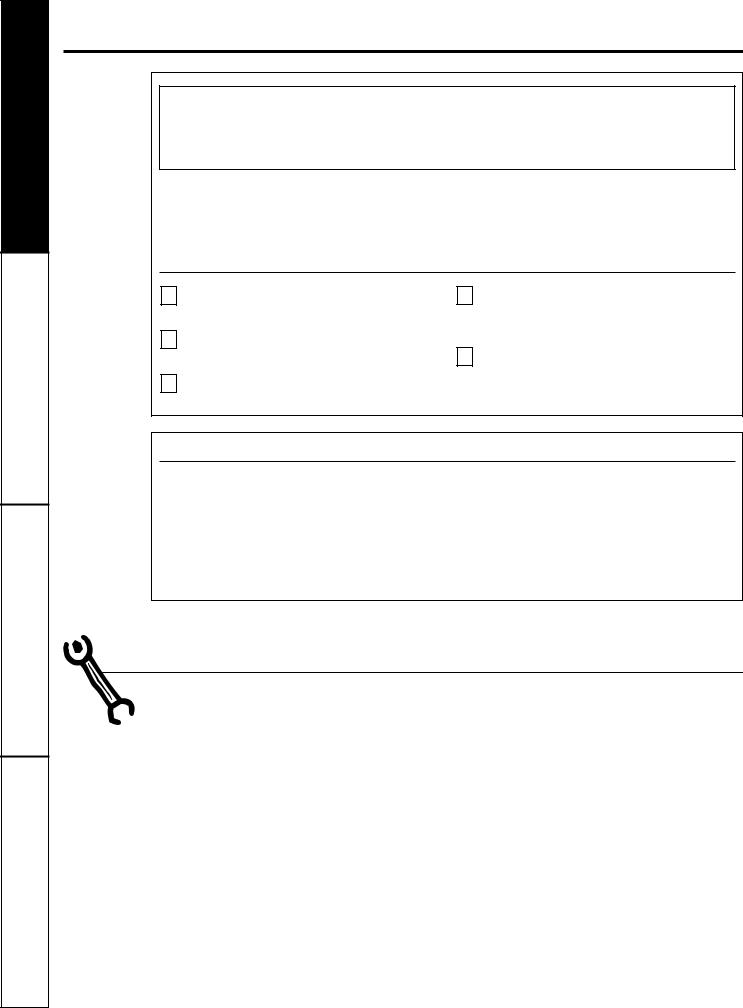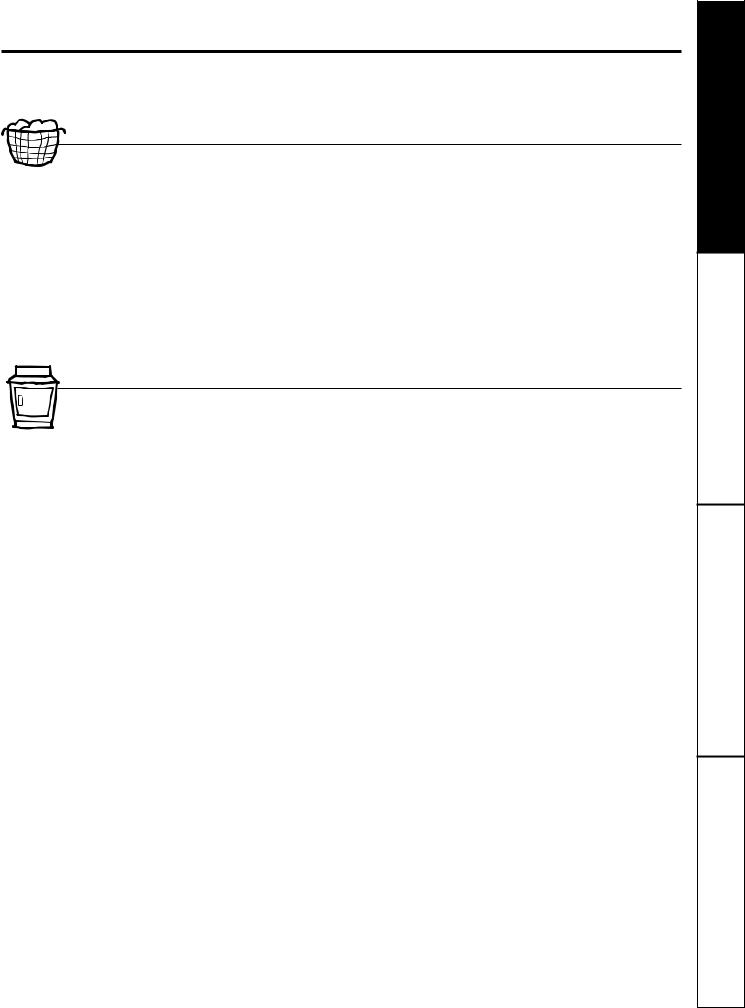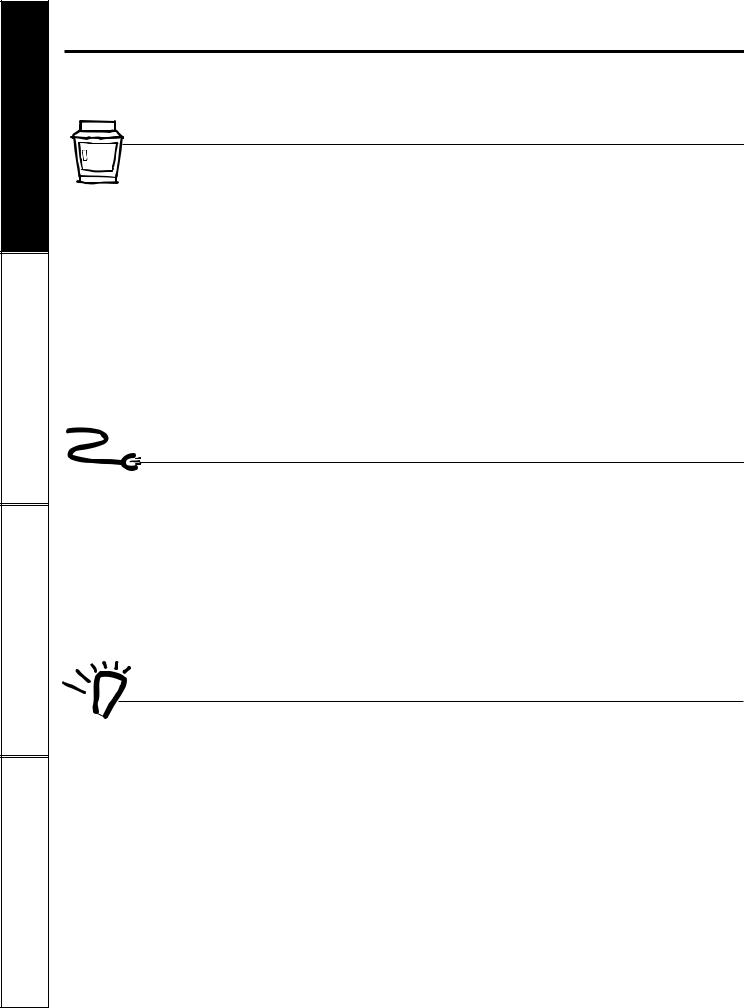GE DRSR483, DX2300, DJXR433, DVLR223, DHDSR45 User Manual
...
Dryers
www.GEAppliances.com
Safety Instructions . . . . . . . 2–4
Operating Instructions
Control Panel . . . . . . . . . . . . 5, 6
Control Settings . . . . . . . . . . . . 7
Features . . . . . . . . . . . . . . . . .8, 9
Loading and Using
the Dryer . . . . . . . . . . . . . . . . .11
Reversing the Door . . . . . . . . . 10
Venting the Dryer . . . . . . . . . .12
Troubleshooting Tips . . . 13, 14
Consumer Support
Consumer Support . . Back Cover
Warranty . . . . . . . . . . . . . . . . . 15
Write the model and serial numbers here:
Model # ________________
Serial # __________________
You can find them on a label on the front of the dryer behind the door.
Owner’s Manual
DBLR333
DBSR453
DBXR463
DHDSR45
DJXR433
DLSR483
DRSR483
DS4500
DVLR223
DWSR483
DWXR483
DX2300
DX4500
EED4500
EGD4500
500A277P053 175D1807P469 49-90200-1 06-04 JR

Safety Instructions
Operating Instructions
Troubleshooting Tips
Consumer Support
IMPORTANT SAFETY INFORMATION.
READ ALL INSTRUCTIONS BEFORE USING.
 WARNING!
WARNING!
For your safety, the information in this manual must be followed to minimize the risk of fire or explosion, electric shock, or to prevent property damage, personal injury, or death.
|
|
■ Do not store or use gasoline or other |
■ Installation and service must be |
flammable vapors and liquids in the |
performed by a qualified installer, |
vicinity of this or any other appliance. |
service agency or the gas supplier. |
|
|
WHAT TO DO IF YOU SMELL GAS:
1
2
3
Do not try to light a match, or cigarette, or turn on any gas or electrical appliance.
Do not touch any electrical switch; do not use any phone in your building.
Clear the room, building or area of all occupants.
4
5
Immediately call your gas supplier from a neighbor’s phone. Follow the gas supplier’s instructions carefully.
If you cannot reach your gas supplier, call the fire department.
California Safe Drinking Water and Toxic Enforcement Act
This act requires the governor of California to publish a list of substances known to the state to cause cancer, birth defects or other reproductive harm and requires businesses to warn customers of potential exposure to such substances.
Gas appliances can cause minor exposure to four of these substances, namely benzene, carbon monoxide, formaldehyde and soot, caused primarily by the incomplete combustion of natural gas or LP fuels.
Properly adjusted dryers will minimize incomplete combustion. Exposure to these substances can be minimized further by properly venting the dryer to the outdoors.
PROPER INSTALLATION
This dryer must be properly installed and located in accordance with the Installation Instructions before it is used. If you did not receive an Installation Instructions sheet, you can receive one by visiting GEAppliances.com, or by calling 800.GE.CARES (800.432.2737).
■Properly ground dryer to conform with all governing codes and ordinances. Follow details in Installation Instructions.
■Install or store where it will not be exposed to temperatures below freezing or exposed to the weather, which could cause permanent damage and invalidate the warranty.
■Connect to a properly rated, protected and sized power supply circuit to avoid electrical overload.
■Remove all sharp packing items and dispose of all shipping materials properly.
Exhaust/Ducting
|
Gas dryers MUST be exhausted to the outside. |
|
1 |
||
|
Use only rigid metal 4″ diameter ductwork |
|
2 |
||
inside the dryer cabinet. Use only rigid metal |
||
|
or flexible metal 4″ diameter ductwork for exhausting to the outside. USE OF PLASTIC OR
OTHER COMBUSTIBLE DUCTWORK CAN CAUSE A FIRE. PUNCTURED DUCTWORK CAN CAUSE A FIRE IF IT COLLAPSES OR BECOMES OTHERWISE RESTRICTED IN USE OR DURING INSTALLATION.
For complete details, follow the Installation Instructions.
2

www.GEAppliances.com
 WARNING!
WARNING!
YOUR LAUNDRY AREA
■Keep the area underneath and around your appliances free of combustible materials
(lint, paper, rags, etc.), gasoline, chemicals and other flammable vapors and liquids.
■Keep the floor around your appliances clean and dry to reduce the possibility of slipping.
■Close supervision is necessary if this appliance is used by or near children. Do not allow children to play on, with or inside this or any other appliance.
■Keep all laundry aids (such as detergents, bleaches, etc.) out of the reach of children, preferably in a locked cabinet. Observe all warnings on container labels to avoid injury.
■Never climb on or stand on the dryer top.
WHEN USING YOUR DRYER
■Never reach into the dryer while the drum is moving. Before loading, unloading or adding clothes, wait until the drum has completely stopped.
■Clean the lint filter before each load to prevent lint accumulation inside the dryer or in the room. DO NOT OPERATE THE DRYER WITHOUT
THE LINT FILTER IN PLACE.
■Do not wash or dry articles that have been cleaned in, washed in, soaked in or spotted
with combustible or explosive substances (such as wax, oil, paint, gasoline, degreasers, dry-cleaning solvents, kerosene, etc.) which may ignite or explode. Do not add these substances to the wash water. Do not use or place these substances around your washer or dryer during operation.
■Do not place items exposed to cooking oils in your dryer. Items contaminated with cooking oils may contribute to a chemical reaction that could cause a clothes load to catch fire.
■Any article on which you have used a cleaning solvent or that contains flammable materials (such as cleaning cloths, mops, towels used in beauty salons, restaurants or barber shops, etc.) must not be placed in or near the dryer until solvents or flammable materials have been removed. There are many highly flammable items used in homes such as acetone, denatured alcohol, gasoline, kerosene, some household cleaners, some spot removers, turpentines, waxes, wax removers and products containing petroleum distillates.
■The laundry process can reduce the flame retardancy of fabrics. To avoid such a result, carefully follow the garment manufacturer’s care instructions.
■Do not dry articles containing rubber, plastic or similar materials such as padded bras, tennis
shoes, galoshes, bath mats, rugs, bibs, baby pants, plastic bags, pillows, etc. that may melt or burn. Some rubber materials, when heated, can under certain circumstances produce fire by spontaneous combustion.
■Do not store plastic, paper or clothing that may burn or melt on top of the dryer during operation.
■Garments labeled Dry Away from Heat or Do Not Tumble Dry (such as life jackets containing Kapok) must not be put in your dryer.
■Do not dry fiberglass articles in your dryer. Skin irritation could result from the remaining particles that may be picked up by clothing during subsequent dryer uses.
■To minimize the possibility of electric shock, unplug this appliance from the power supply or disconnect the dryer at the household distribution panel by removing the fuse or switching off the circuit breaker before attempting any maintenance or cleaning (except the removal and cleaning of the lint filter). NOTE: Turning the Cycle Selector knob to an off position or pressing PAUSE does NOT
disconnect the appliance from the power supply.
3
Instructions Safety
Instructions Operating
Tips Troubleshooting
Support Consumer

Safety Instructions
Operating Instructions
Troubleshooting Tips
Consumer Support
IMPORTANT SAFETY INFORMATION. READ ALL INSTRUCTIONS BEFORE USING.
 WARNING!
WARNING!
WHEN USING YOUR DRYER (cont.)
■Never attempt to operate this appliance if it is damaged, malfunctioning, partially disassembled, or has missing or broken parts, including a damaged cord or plug.
■The interior of the machine and the exhaust duct connection inside the dryer should be cleaned at least once a year by a qualified technician. See the Loading and Using the Dryer section.
■If yours is a gas dryer, it is equipped with an automatic electric ignition and does not have a pilot light. DO NOT ATTEMPT TO LIGHT WITH A MATCH. Burns may result from having your hand in the vicinity of the burner when the automatic ignition turns on.
■You may wish to soften your laundered fabrics or reduce the static electricity in them, by using a dryer-applied fabric softener or an anti-static conditioner. We recommend you use either a fabric softener in the wash cycle, according to the manufacturer’s instructions for those products, or try a dryer-added product for which the manufacturer gives written assurance on the package that their product can be safely used in your dryer. Service or performance problems caused by use of these products are the responsibility of the manufacturers of those
products and are not covered under the warranty to this appliance.
WHEN NOT USING YOUR DRYER
■Grasp the plug firmly when disconnecting this appliance to avoid damage to the cord while pulling. Place the cord away from traffic areas so it will not be stepped on, tripped over or subjected to damage.
■Do not attempt to repair or replace any part of this appliance or attempt any servicing unless specifically recommended in this Owner’s Manual or in published user-repair instructions that you understand and have the skills to carry out.
■Before discarding a dryer, or removing it from service, remove the dryer door to prevent children from hiding inside.
■Do not tamper with controls.
 READ AND FOLLOW THIS SAFETY INFORMATION CAREFULLY.
READ AND FOLLOW THIS SAFETY INFORMATION CAREFULLY.


 SAVE THESE INSTRUCTIONS
SAVE THESE INSTRUCTIONS
4

About the dryer control panel. |
www.GEAppliances.com |
You can locate your model number on the label on the front of the dryer behind the door. Throughout this manual, features and appearance may vary from your model.
Model DVLR223
3 |
2 |
Model DX2300
|
3 |
2 |
Models DS4500, DBSR453, DBXR463 and DHDSR45 |
|
|
|
|
Optional features |
|
|
(on some models) |
3 |
1 |
2 |
Model DX4500
3 |
1 |
2 |
NOTE: Drying times will vary according to the type of heat used (Electric, Natural or LP gas), size of load, types of fabrics, wetness of clothes and condition of exhaust ducts.
5
